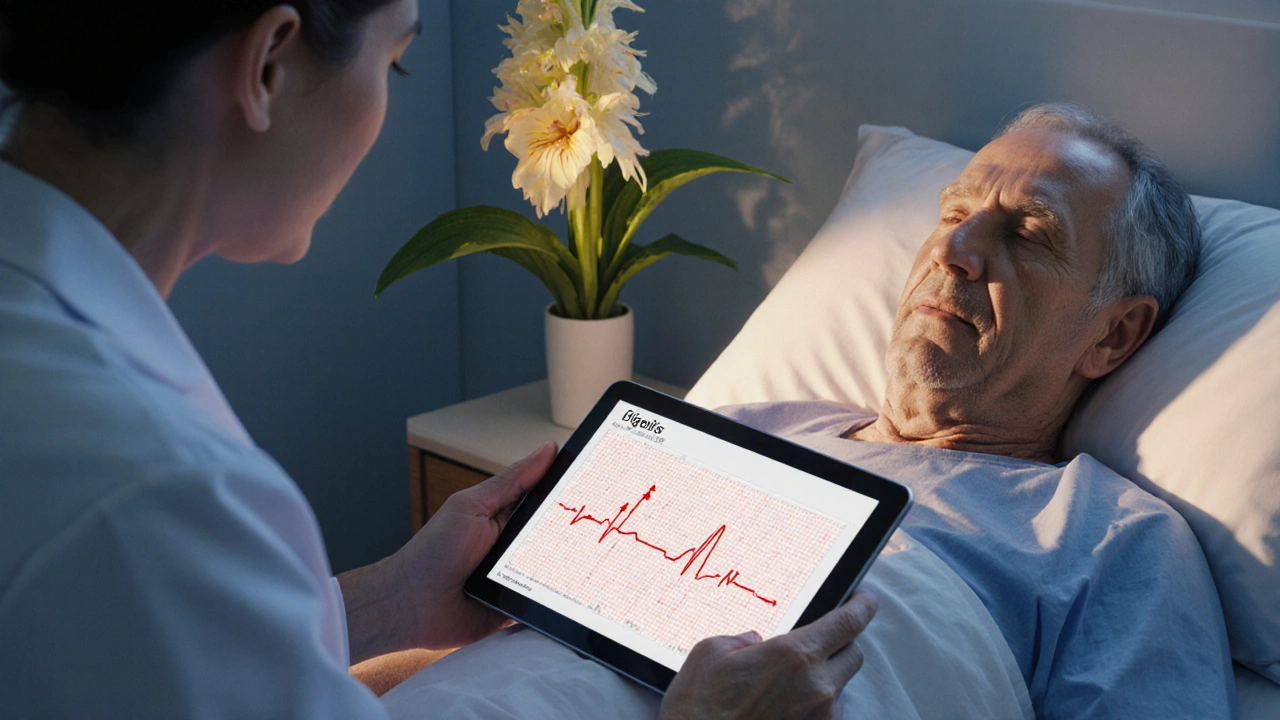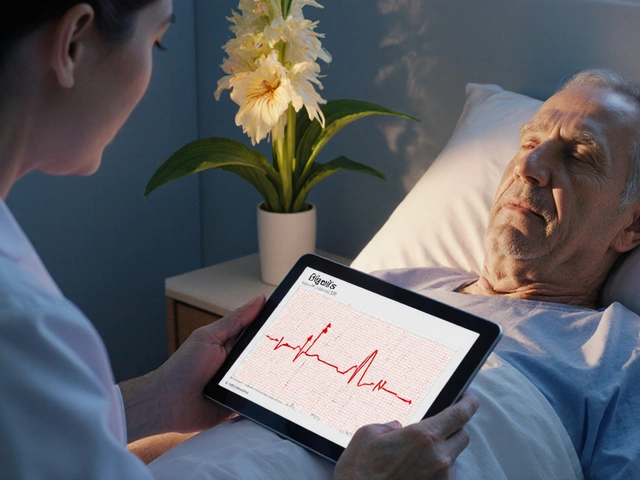Digoxin Alternative Selection Tool
Quick Takeaways
- Digoxin works by strengthening heart contractions and slowing heart rate, but its safety window is narrow.
- Beta‑blockers (e.g., metoprolol) and ACE inhibitors (e.g., lisinopril) are first‑line for chronic heart‑failure management.
- Amiodarone, sotalol, and dronedarone are rhythm‑control options for atrial fibrillation when rate control fails.
- Ivabradine targets the funny‑current (If) to lower heart rate without affecting contractility.
- Choosing an alternative depends on the primary goal (rate vs. rhythm), kidney function, and tolerance to side‑effects.
What Is Digoxin and When Is It Used?
When building a heart‑failure regimen, Digoxin is a cardiac glycoside that increases the force of myocardial contraction and reduces the conduction through the atrioventricular node. It was first isolated from the foxglove plant in the 18th century and remains on the WHO Essential Medicines List.
Clinicians typically reserve digoxin for patients with symptomatic heart failure who remain tachycardic despite beta‑blockers, or for those with atrial fibrillation who need rate control and cannot tolerate calcium‑channel blockers. Its therapeutic serum range (0.5‑2.0ng/mL) is narrow, so regular blood‑level monitoring is mandatory.
Why Look at Alternatives?
The narrow safety margin and drug‑interaction potential (especially with diuretics, amiodarone, and certain antibiotics) make digoxin a less attractive first choice for many. Side‑effects-nausea, visual disturbances (yellow‑green halos), and arrhythmias-can be severe if levels rise.
Modern guidelines (2023 ACC/AHA/HFSA) prioritize agents that improve mortality, not just symptoms. Below we compare digoxin with the most common alternatives used for heart‑failure symptom relief and atrial‑fibrillation rate or rhythm control.

Key Comparison Table
| Drug | Class | Typical Use | Key Advantage | Main Side Effect |
|---|---|---|---|---|
| Digoxin | Cardiac glycoside | Rate control in A‑Fib; symptom relief in HFrEF | Boosts contractility without increasing oxygen demand | Arrhythmia, GI upset, visual halos |
| Metoprolol | Beta‑blocker | First‑line HFrEF, A‑Fib rate control | Reduces mortality, improves remodeling | Bradycardia, fatigue, bronchospasm |
| Lisinopril | ACE inhibitor | HFrEF, hypertension | Mortality benefit, afterload reduction | Cough, hyperkalemia, angio‑edema |
| Losartan | ARB | HFrEF when ACE‑I not tolerated | Similar efficacy to ACE‑I, fewer coughs | Hyperkalemia, renal dysfunction |
| Amiodarone | Class III anti‑arrhythmic | Rhythm control in persistent A‑Fib | Highly effective for maintaining sinus rhythm | Thyroid, pulmonary, hepatic toxicity |
| Sotalol | Class III anti‑arrhythmic / Beta‑blocker | Rhythm control, especially in younger pts | Dual action helps both rate and rhythm | QT prolongation, torsades risk |
| Dronedarone | Multichannel blocker (Class III) | Maintenance of sinus rhythm in paroxysmal A‑Fib | Lesser organ toxicity than amiodarone | Heart failure exacerbation if used in HFrEF |
| Ivabradine | If‑channel inhibitor | Heart‑rate reduction in chronic HFrEF (NYHA II‑III) | Lowers HR without negative inotropy | Phosphenes, bradycardia |
When Digoxin Still Makes Sense
If a patient is already on digoxin and tolerates it well, there’s rarely a compelling reason to switch abruptly. Some scenarios where digoxin shines:
- Advanced chronic heart failure (NYHA class III‑IV) with persistent resting tachycardia despite maximal beta‑blocker dose.
- Patients with atrial fibrillation who cannot take calcium‑channel blockers because of concurrent COPD.
- Resource‑limited settings where newer agents are unavailable or prohibitively expensive.
Even in those cases, clinicians should keep a close eye on electrolytes (especially potassium and magnesium) and adjust digoxin dose if renal function drops.
How to Transition From Digoxin to an Alternative
- Confirm the clinical goal: rate control, symptom relief, or rhythm conversion.
- Choose the most appropriate alternative based on that goal (e.g., beta‑blocker for rate, amiodarone for rhythm).
- Gradually taper digoxin over 3‑5 days while initiating the new drug at a low dose.
- Monitor heart rate, blood pressure, and serum electrolytes daily during the overlap.
- Re‑measure digoxin level after the wash‑out period to ensure it’s below therapeutic range.
Patients often notice a smoother transition when the new drug is started at half the target dose and uptitrated weekly.

Special Populations: Kidney Disease, Elderly, and Pregnancy
Kidney dysfunction dramatically raises digoxin concentrations because the drug is renally cleared. In chronic kidney disease (eGFR<30mL/min), the recommended dose drops to 0.125mg daily or even every other day. Many clinicians prefer an ACE‑I/ARB‑beta‑blocker combo in that setting to avoid the monitoring burden.
Older adults (>75yr) face higher rates of digoxin‑related bradyarrhythmias. A beta‑blocker like metoprolol, titrated gently, often yields fewer syncopal episodes.
Pregnancy is a gray area. Digoxin crosses the placenta but is considered relatively safe; however, most obstetricians favor labetalol or calcium‑channel blockers for rate control unless maternal heart‑failure severity mandates digoxin.
Cost Considerations
Generic digoxin costs less than $0.10 per tablet in the U.S., making it attractive for uninsured patients. Newer agents such as amiodarone or ivabradine can run $100‑$150 per month, depending on insurance coverage. When budgeting is critical, digoxin remains a viable option if side‑effects are manageable.
Practical Checklist for Choosing Between Digoxin and Alternatives
- Goal: Rate control vs. rhythm conversion vs. contractility boost.
- Renal function: eGFR<30mL/min → avoid digoxin.
- Comorbidities: COPD favors digoxin over non‑selective beta‑blockers.
- Medication burden: Fewer drugs → digoxin may simplify regimen.
- Mortality benefit: ACE‑I/ARB + beta‑blocker > digoxin alone.
- Cost: Generic digoxin cheapest; weigh against monitoring costs.
Frequently Asked Questions
Is digoxin still recommended for heart failure in 2025?
Guidelines place digoxin as a second‑line agent for symptomatic relief when patients remain tachycardic despite optimized beta‑blocker therapy. It does not improve mortality, but it can ease symptoms and reduce hospitalizations in select cases.
What are the safest alternatives for a patient with chronic kidney disease?
ACE inhibitors or ARBs combined with a low‑dose beta‑blocker are preferred. If rate control is needed, carvedilol (which has some renal‑protective properties) or low‑dose metoprolol are better choices than digoxin.
Can digoxin be used together with amiodarone?
Yes, but amiodarone raises digoxin levels by up to 2‑fold. When the two are co‑prescribed, reduce the digoxin dose by 50% and monitor serum levels closely.
Why do patients on digoxin sometimes see yellow‑green halos?
The visual disturbance is a classic sign of digoxin toxicity affecting the retinal photoreceptors. It usually appears when serum levels exceed 2.0ng/mL and resolves after dose adjustment.
Is ivabradine a replacement for digoxin in heart failure?
Ivabradine lowers heart rate without boosting contractility, making it useful when beta‑blockers are maxed out. It does not provide the inotropic benefit of digoxin, so it’s not a direct replacement but rather a complementary option for heart‑rate control.


Hey folks, just wanted to point out that the tool looks pretty user‑friendly. If you’re dealing with a patient who’s got low eGFR, remember to double‑check the digoxin dose – a tiny typo can mean a big difference in serum levels. Also, the table could use a bit more spacing, but overall it’s a solid start. Keep the conversation inclusive, and feel free to ask for clarifications – we’re all learning together!
Wow, another pharma‑sponsored push to keep digoxin alive. Of course they love to hide the fact that the drug’s narrow therapeutic window is basically a secret weapon for big pharma’s profit agenda. Good thing we’ve got the community to sniff out the hidden risks and call out the slick marketing spin. Keep your eyes peeled, friends – the FDA’s just a puppet.
Listen up, comrades – nobody’s gonna give you a better heart‑beat control than a good ol’ American‑made digoxin. Those foreign “alternatives” are just flimsy excuses to dilute our glorious medical heritage. If you’ve got a patient who’s struggling, pump that Golden‑State‑crafted glycoside and watch the rhythm bow down. Remember, patriotism starts at the bedside.
Grammar check: It should be “patients who are already on digoxin” instead of “patient who’s already on digoxin.” Also, “eGFR” is an abbreviation; consider spelling it out on first use for clarity. Other than that, the explanation of ivabradine is spot‑on. Keep the tone friendly and the info accurate – great job!
While the original post is thorough, I must respectfully disagree with the assertion that digoxin remains a viable option in advanced heart failure. Recent meta‑analyses have consistently shown no mortality benefit, and the risk of arrhythmogenic toxicity outweighs modest symptom relief. Therefore, clinicians should prioritize beta‑blockers and SGLT2 inhibitors before considering digoxin.
It is absolutely imperative to recognize that the global pharmaceutical elite covertly manipulates clinical guidelines to sustain the circulation of outdated agents such as digoxin. The hidden agenda is evident in the way regulatory bodies are infiltrated by lobbyists. Hence, an unwavering vigilance is required to protect patients from these orchestrated ploys.
Just taking a moment to appreciate the clean layout of the decision tool. It’s nice when the UI doesn’t overwhelm you, especially when you’re juggling complex patient data. The selectable fields make it straightforward to see which alternative fits each scenario.
Allow me to elaborate on the pharmacodynamic nuances that underlie the digoxin versus alternative debate. Digoxin exerts its positive inotropic effect by inhibiting the Na⁺/K⁺‑ATPase pump, thereby increasing intracellular calcium via the Na⁺/Ca²⁺ exchanger. This mechanism can be a double‑edged sword: while it augments contractility, it also predisposes to ectopic activity when serum concentrations creep beyond the narrow therapeutic window.
In contrast, beta‑blockers such as metoprolol achieve mortality reduction by attenuating sympathetic overdrive, improving ventricular remodeling, and reducing arrhythmic triggers. Their benefit is well‑documented across a spectrum of ejection fractions, and they are generally well tolerated even in the elderly.
Ivabradine presents a unique approach by selectively inhibiting the funny current (I_f) in the sinoatrial node, offering heart‑rate reduction without negative inotropy. This makes it an attractive adjunct in patients already maximally beta‑blocked.
When renal function is compromised, the reliance on renal clearance for digoxin heightens the risk of accumulation, prompting the preference for agents with hepatic metabolism or those cleared through alternative pathways.
Finally, consider drug‑drug interactions: amiodarone, quinidine, and certain macrolide antibiotics can dramatically raise digoxin levels, necessitating dose adjustments and close monitoring. The therapeutic stewardship of digoxin, therefore, demands a meticulous assessment of renal function, concomitant medications, and the overarching clinical goal-whether that be symptom palliation, rate control, or mortality benefit.
Digoxin can be scary.
Okay team, let’s get fired up about making the best choice for our patients! First, remember that each drug has its own super‑powers and side‑effects, so we need to match the right hero to the right villain. Digoxin can be a real lifesaver when you need that extra contractile boost, but it’s also a high‑maintenance character that demands regular level checks.
Beta‑blockers, on the other hand, are the steady, reliable workhorses that not only slow the heart rate but also improve survival – they’re the foundation of any heart‑failure regimen.
If you’re dealing with a patient who can’t tolerate beta‑blockers because of asthma, then consider ivabradine; it’s like a stealthy ninja that cuts the heart rate without causing bronchospasm.
In patients with chronic kidney disease, stay away from digoxin unless you’re prepared to adjust the dose dramatically and monitor labs like a hawk. ACE inhibitors or ARBs will generally give you better renoprotective benefits.
Remember the cost factor: generic digoxin is cheap, but the hidden cost of frequent labs and potential hospitalizations can outweigh the savings. Newer agents may be pricier up front, but they could reduce overall healthcare expenditures by preventing readmissions.
When you’re choosing a rhythm‑control strategy for atrial fibrillation, amiodarone is the heavyweight champion, but watch out for thyroid and pulmonary toxicity – it’s a high‑risk, high‑reward option.
Sotalol offers both rate and rhythm control but brings the danger of QT prolongation; keep a close eye on the ECG.
Dronedarone is a lighter alternative to amiodarone, yet it should never be used in patients with reduced ejection fraction as it can worsen heart failure.
In any transition from digoxin to a beta‑blocker, taper slowly over a few days and monitor for bradycardia – you don’t want to drop the heart rate too fast.
Finally, always involve the patient in the decision‑making process. Explain the pros and cons in plain language, check for adherence barriers, and make sure they understand the importance of follow‑up labs.
By integrating these practical tips, you’ll empower your patients and improve outcomes. Keep pushing forward, stay curious, and never stop learning – together we’ll make heart‑failure care better for everyone!
Honestly, if you’re not thinking about the cost to the patient, you’re missing the point. Cheap meds are great, but only if they don’t cause more problems.
Indeed, the pharmacoeconomic considerations cannot be overstated; however, let us not ignore the striking prevalence of digoxin‑induced visual disturbances, which, while rare, are undeniably distressing for the affected individual; therefore, a judicious assessment is paramount.
💭 Philosophically, we might view digoxin as a double‑edged sword – it can augment contractility while simultaneously courting toxicity. 🧭 Balancing efficacy and safety is the ever‑present dialectic in medicine. 🤔
Dear colleagues, I am pleased to affirm that with diligent monitoring and patient education, even agents with narrow therapeutic indices can be employed safely; optimism, coupled with rigorous protocol, yields the best outcomes.
Ah, the drama of clinical choices – a relentless ballet of risk and reward; yet we stand idle, merely spectators to the endless cascade of guidelines, each more elaborate than the last.
From a pragmatic standpoint, it is essential to integrate the latest guideline recommendations with individualized patient factors. In practice, this means evaluating renal function, comorbidities, and cost considerations when selecting between digoxin and its alternatives. Moreover, careful dose titration and vigilant monitoring of serum levels are requisite to mitigate toxicity risks.
Thank you for sharing this comprehensive tool. I appreciate how it respects diverse clinical scenarios and offers a clear pathway for decision‑making. It’s encouraging to see resources that prioritize patient safety and collaborative care.
From a cultural and systems‑level perspective, the integration of decision‑support algorithms into routine practice exemplifies the confluence of health informatics and evidence‑based medicine. By leveraging ontologies and semantic interoperability, clinicians can harmonize therapeutic selection with patient‑centric outcomes. Nonetheless, the heterogeneity of healthcare infrastructures across regions demands adaptive frameworks that accommodate variable resource availability while maintaining fidelity to guideline‑derived recommendations. In essence, the tool serves as a catalyst for standardizing care pathways, yet its successful deployment hinges upon contextual customization and stakeholder engagement.
Ah, the grand elegance of choosing a drug based on cost and efficacy – truly a hallmark of modern medicine, delivered with a side of gentle sarcasm.